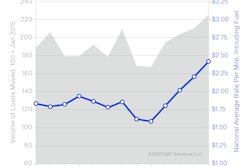
Today’s complex food supply chains rely on many suppliers to satisfy the requirements of government regulatory agencies such as the Food and Drug Administration’s (FDA), Sanitary Transportation of Human and Animal Food mandate, among others. In addition, as Food Safety Modernization Act (FSMA) regulations continue to impact the industry, companies are implementing new ways to safely bring food products to market.
However, supply chains don’t always go as planned, and when you find yourself with an unmet supply need, you will need to leverage high-quality data in order to quickly pivot and find new solutions. Let’s face it, supplier failure is an inevitability. The Coronavirus disease (COVID-19) pandemic showed us emergency-level supplier failure, but failure can also occur when a supplier stops being able to meet your needs in terms of budget, timing, regulations or a variety of other factors. Regardless of the specific reasons, there will come a time when your plans and expectations for a supplier will not be met, and you need a plan for when that time comes.
Supplier failure becomes much easier to navigate when you’re set up to be agile, informed and open to innovative solutions. The first step to achieving this state of preparedness is to have high quality supplier data to base your decisions on. Trusted data can support visibility, and present you with new solutions that you might not have previously considered. When pivoting after a supplier failure, you may consider working with new suppliers and having to onboard them quickly.
Failure can mean opportunity
When it comes to evaluating whether or not a new supplier is right for you, look for both quantitative and qualitative markers of their credibility. In this way, you can reframe supplier failure as an opportunity to re-evaluate the quality of your supplier data, your current supplier network and relationships, and areas for optimization and cost-savings, including quality, risk, sustainability, diversity goals. You shouldn't need to spend hours or days vetting suppliers. There are technological advancements in the industry, spurred by artificial intelligence (AI) and machine learning (ML) that will enable you to perform data analytics that will provide actionable insights.
The broader the pool of suppliers to be considered for any sourcing effort, the more robust the enabling technology must be. Internet searches are a poor solution when trying to meet complex, nuanced supplier requirements. Even traditional supplier databases and portals leave much to be desired. They are static and fail to address sustainability-related innovation because they only contain already known suppliers and the already known capabilities of suppliers that may have expanded their offerings over time. Instant visibility across the organization along with enriched, predictive supplier information allows for the faster formation of better third-party relationships. The first step in finding a supplier with specialized or sustainable capabilities is building a shortlist of qualified suppliers, and that process is made easier when starting with a comprehensive, easy to search trusted supplier master.
Once you’ve determined that your supplier data is high quality, here are ways to leverage that data to quickly recover from supplier failure.
Determine where you can be flexible
When unprecedented situations arise, project details may need to change to most efficiently achieve objectives. Things like timeline and budget should be considered, as well as the expectations you have for suppliers, including parameters such as size, location and primary industry served.
For example, a large U.S-based food manufacturer typically used large-scale international suppliers for items like beverage caps. However, when borders began to close and tariffs began to rise following the effects of COVID-19, this manufacturer found a workaround when they turned to smaller suppliers who had previously only distributed regionally. In this situation, location and size of the supplier was originally seen as an indicator of the supplier’s capability, but this manufacturer found that by being open to smaller and more localized suppliers, they were still able to get their needs rapidly met.
Look for credibility markers
When recovering from a supplier failure, you may also consider working with new suppliers. To evaluate whether or not a new supplier is right for you, look for both quantitative and qualitative markers of their credibility. These credibility markers might be tangible things like quality or environmental certifications the supplier has obtained. They can also be reputation-based. Who is this supplier currently working with? How are they performing in RFIs? Who endorses them? Are those endorsements unbiased, and do they reflect the same needs of your situation?
However, when searching for endorsements, be mindful of bias or irrelevant information. Instead, look for qualitative reviews that reflect the needs of your situation.
Consider diversifying your food supplier vendor list
Diverse suppliers can often meet the same expectations as the suppliers you have pre-existing relationships with, but they may be more difficult to find. A supplier failure is a good opportunity to introduce more diverse spend into your procurement strategy.
By introducing more diverse spend, you can potentially add value back into your company in the form of government rebates. Consider this if a quote from a diverse supplier is higher than expected. In fact, it may be balanced out by the benefits of increasing diversity spend. Moreover, the local/regional suppliers typically qualify for diversity certifications which can add value back to the company and nullify what may be a higher cost. Another benefit of working with a local/regional supplier is the ability to cut logistical costs tied to orders or contracts.
Understand the potential impact on your existing network
When you add more diverse suppliers to your list after a supplier failure, these changes can impact your entire supplier ecosystem. This new supplier network could introduce benefits that trickle down to all stakeholders. For example, new suppliers may solve problems you didn’t even know you had, in areas like quality, sustainability, diversity goals and more. Evaluating these areas and using quality data to inform your decisions-making should make re-alignment from a supplier failure much easier for your organization. The emphasis on clean, trusted data in procurement may be new, but the effects of having it will positively reverberate as your organization moves forward into the future. During times of crisis, information is always available, even when people are not.
Trusted data can support increased supplier visibility and present new solutions that might not have previously considered. In this way, we can reframe supplier failure in the food supply chain as an opportunity to re-evaluate the quality of supplier data and open up new opportunities to succeed, even in difficult times.
















